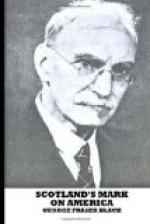notable creations—is amply attested by
Grace Church, Calvary Church, and St. Patrick’s
Cathedral, in New York; the Smithsonian Institution
and Corcoran Art Gallery, in Washington; and Vassar
College in Poughkeepsie. John McArthur (1823-90),
born in Bladenoch, Wigtownshire, designed and constructed
Philadelphia City Hall, Lafayette College, the “Public
Ledger” building in Philadelphia, several hospitals,
etc. Alexander Campbell Bruce (b. 1835),
of Scottish parentage, designed a number of court-houses
and other public buildings in Tennessee, Georgia,
Alabama, Florida, and North Carolina, besides schools,
libraries, churches, hotels,
etc. He easily
became the foremost architect of the South. Henry
Hobson Richardson (1838-86), of Scottish descent, drew
the plans for many important buildings, but Trinity
Protestant Episcopal Church in Boston, is considered
his masterpiece. James Hamilton Windrim (b. 1840),
architect and Director of Public Works in Philadelphia,
was of Ulster Scot parentage. His services were
utilized in the planning and construction of some
of the most important buildings in Philadelphia.
The Masonic Temple in that city is believed to be
his masterpiece. The designer of many of the notable
bridges of Philadelphia was Frank Burns (1844-1913),
an architectural draughtsman of Scottish descent.
Harold Van Buren Magonigle (b. 1867), designer of
the monument to the Seamen of U.S.S.
Maine (1900),
Cornell Alumni Hall, Ithaca, the National McKinley
Memorial at Canton, Ohio,
etc., is the grandson
of John Magonigle of Greenock. The builder of
the world famed Smithsonian Institution in Washington
was Gilbert Cameron (d. 1866), a native of Greenock,
and Scottish stone-masons were largely employed in
the construction of many of the most important buildings
in the country, such as the Metropolitan Museum and
Tombs in New York, the Capitol in Albany, the State
House in Boston, the City Hall in Chicago,
etc.
Alexander McGaw (1831-1905), born in Stranraer, Wigtownshire,
was famous as a bridge-builder and as builder of the
pedestal of the Statue of Liberty in New York Harbor.
John L. Hamilton (1835-1904), born in Newmilns, Ayrshire,
came to the United States in 1853, and soon became
eminent as a builder.
Duncan Phyfe, maker of exquisite furniture, who adapted
and improved the Sheraton style, and considered by
good judges to be the equal of Sheraton, Hipplewhite,
and Adams, was a Scot who came to America about 1784.
His father was John Fife of Inverness. Dyer, who
devotes a chapter of his Early American Craftsmen
to him, says “no other American made anything
comparable to ... the exquisite furniture of Duncan
Phyfe.” The name of Samuel McIntire (d.
1811) stands out pre-eminent as master of all the
artists in wood of his time. An account of his
work is given by Dyer with illustrations of his work.
In 1812, Thomas Haig, a native of Scotland, a Queensware
potter, started the Northern Liberties Pottery, and




